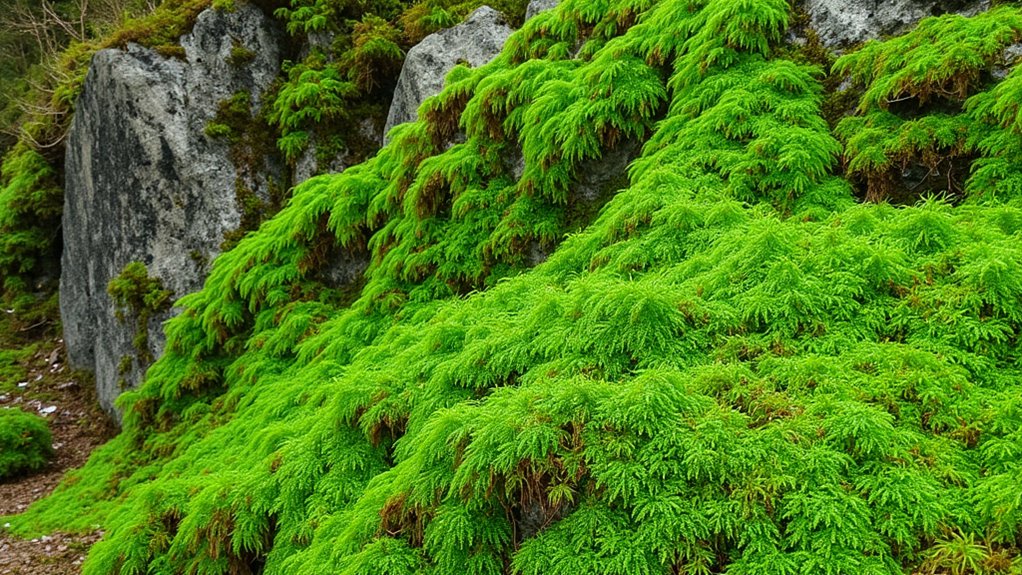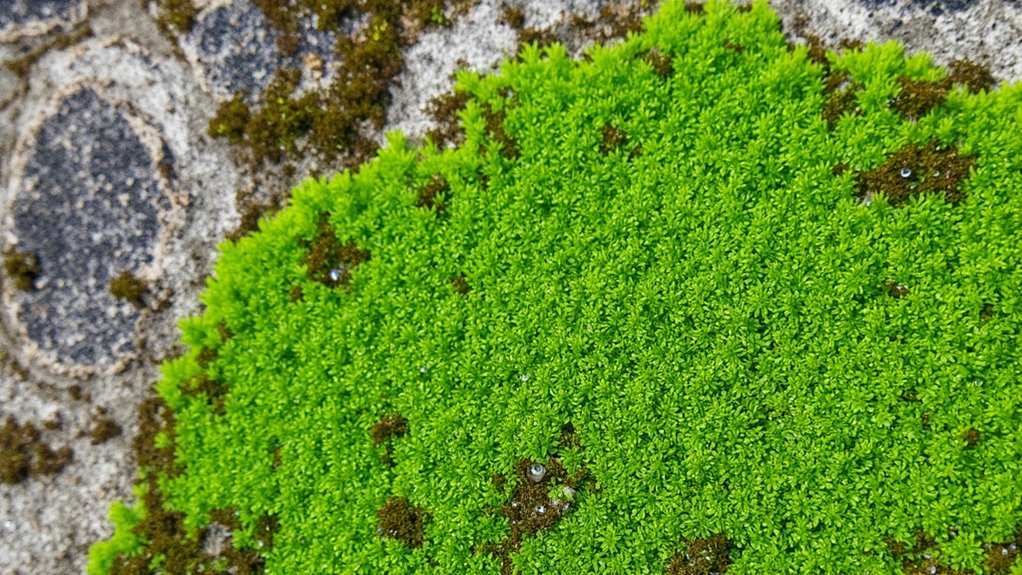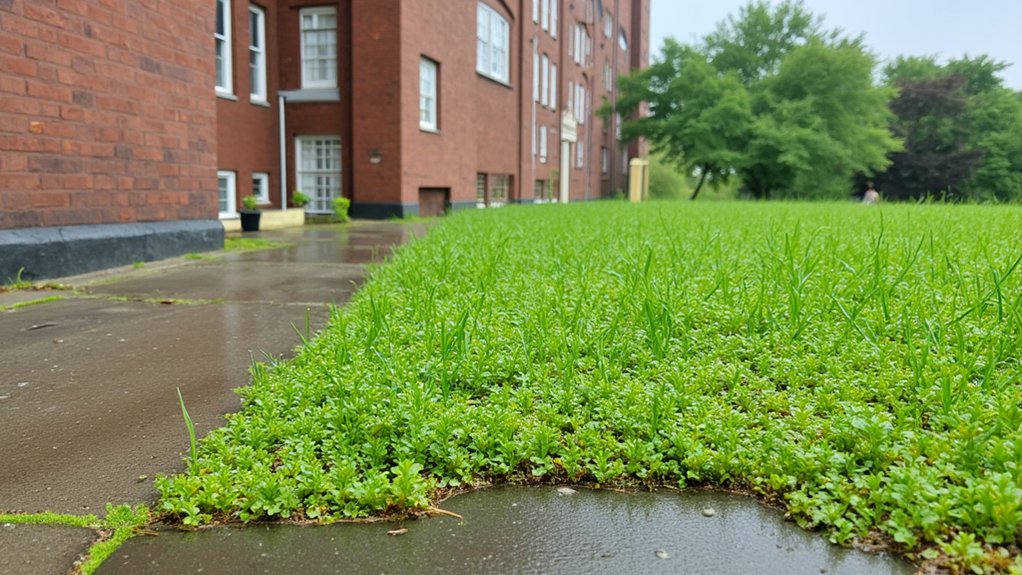Moss covers roughly 30% of Earth’s land surface, yet you’ll rarely spot it growing higher than 1 inch tall. You’ve likely walked past this remarkable plant countless times without noticing its clever survival tactics, from absorbing water through its leaves to thriving in spaces as thin as a credit card. While it might seem insignificant at first glance, moss’s ability to colonize seemingly inhospitable environments holds secrets that modern scientists are just beginning to understand.
Contents
- 1 The Ancient Origins of Earth’s Living Carpet
- 2 Survival Without Roots: Moss’s Unique Adaptations
- 3 Urban Warriors: How Moss Conquers City Landscapes
- 4 Nature’s Water Management Experts
- 5 The DNA Repair Masters of the Plant World
- 6 Moss as Ecosystem Engineers
- 7 From Sidewalk Cracks to Rooftops: Unexpected Habitats
- 8 The Hidden Benefits of Moss in Modern Environments
- 9 Preserving Moss Communities for Future Generations
The Ancient Origins of Earth’s Living Carpet

While dinosaurs may get most of the attention when discussing Earth’s prehistoric past, moss has been quietly thriving on our planet for over 470 million years. You’ll find evidence of these ancient plants in fossils dating back to the Ordovician Period, when moss first colonized land.
These resilient pioneers helped create the soil that later plants would need to survive. Through a process called bioerosion, moss gradually broke down rocks by secreting mild acids and trapping moisture against stone surfaces. You can still observe this same process today when you spot moss growing on concrete walls or rocky outcrops.
Survival Without Roots: Moss’s Unique Adaptations

Unlike most plants you’ll encounter in your garden, moss thrives without a true root system. Instead, you’ll find tiny thread-like structures called rhizoids that anchor the plant to surfaces, while absorbing water and nutrients directly through its leaves.
This unique adaptation lets moss colonize places where other plants can’t survive, from bare rock faces to urban sidewalks. Each leaf contains specialized cells that can store water for weeks, while the plant’s compact structure helps it retain moisture.
When conditions get too dry, moss can enter a dormant state, then spring back to life when water returns.
Urban Warriors: How Moss Conquers City Landscapes

These remarkable survival abilities make moss perfectly suited for modern urban environments. You’ll find it thriving in sidewalk cracks, on building facades, and along concrete walls, where it can extract nutrients from air pollution and rainfall.
In cities, moss acts as a natural air filter, with just one square yard capable of removing up to 20 pounds of airborne particles annually. It’s also remarkably tolerant of heavy metals, converting toxic compounds into less harmful forms.
You’ll notice moss colonizing seemingly inhospitable surfaces like brick and metal, establishing itself within 2-3 months if conditions are right. It only needs minimal moisture and indirect light to transform harsh cityscapes into living green spaces.
Nature’s Water Management Experts
Because moss possesses specialized cells called papillae, it’s one of nature’s most efficient water managers. You’ll find these tiny structures dotting the surface of moss leaves, where they capture and distribute water with remarkable precision.
When you examine moss closely, you’ll notice it can absorb water up to 20 times its weight in just seconds. The papillae work like microscopic sponges, pulling moisture from rain, fog, and even humid air. They’ll store this water between their cells and slowly release it when conditions become dry.
This unique system lets moss thrive in places where other plants can’t survive, from concrete walls to bare rock faces.
The DNA Repair Masters of the Plant World
While most plants suffer severe DNA damage from UV radiation, moss species have evolved extraordinary molecular repair mechanisms that you’ll find fascinating. These tiny plants can repair their DNA up to 50 times faster than other vegetation, using specialized proteins called photolyases.
You’ll notice that moss thrives in exposed, high-altitude locations where UV radiation is intense. That’s because their cells contain up to three times more repair enzymes than typical plants. When UV rays strike their DNA, these enzymes spring into action within milliseconds, mending broken strands and preventing mutations that would kill ordinary plants.
Moss as Ecosystem Engineers
Moss species don’t just repair themselves – they actively transform entire landscapes into thriving habitats. As ecosystem pioneers, they’ll colonize bare rock, creating a living foundation that traps moisture, organic matter, and minerals.
You’ll find these tiny engineers breaking down surfaces through chemical secretions, accelerating the weathering process up to 100 times faster than normal. Their dense mats retain up to 20 times their weight in water, preventing erosion and creating microhabitats.
Watch how they facilitate succession – as moss accumulates nutrients and organic matter, they prepare the ground for larger plants, fundamentally kick-starting entire ecosystems from scratch.
From Sidewalk Cracks to Rooftops: Unexpected Habitats
Despite their reputation as forest dwellers, you’ll find these adaptable plants thriving in the most surprising urban locations. Look between concrete sidewalk segments, and you’ll spot moss colonies establishing micro-gardens in cracks as narrow as 1/16 inch wide.
Urban moss doesn’t limit itself to ground level. These hardy plants colonize rooftops, particularly on north-facing slopes where moisture tends to linger. You’ll spot them on brick walls, metal drain pipes, and even air conditioning units, where condensation provides a consistent water source.
In parking lots, you’ll discover moss transforming sterile asphalt islands into living oases, often starting in spots where water regularly drips from vehicles.
Beyond their humble appearance, these remarkable plants serve as environmental powerhouses in today’s urban landscapes. You’ll find moss absorbing up to 20 times its weight in water, reducing stormwater runoff and preventing erosion on green roofs and walls.
These miniature forests also function as natural air purifiers, trapping particles as small as 10 micrometers while converting CO2 to oxygen. You can harness moss’s ability to remove lead and copper from rainwater, making it an excellent bio-monitor for urban pollution.
In modern architecture, you’ll see moss being integrated into “living walls,” where it provides natural insulation, reducing building energy costs by up to 15%.
Preserving Moss Communities for Future Generations
While our planet’s biodiversity faces mounting challenges, you’ll find that protecting moss communities requires a coordinated blend of local conservation and scientific monitoring. You can start by documenting local moss species using GPS mapping and maintaining detailed growth records over 6-12 month periods.
In your own community, you’ll want to establish protected zones of at least 10 square meters where moss can thrive undisturbed. These areas need 60-70% shade coverage and consistent moisture levels between 60-80%. Don’t forget to monitor pH levels, which should stay between 5.0 and 6.5 for most species.
Remember to share your conservation data with regional botanical gardens and universities, as they’re building valuable databases for future research.
